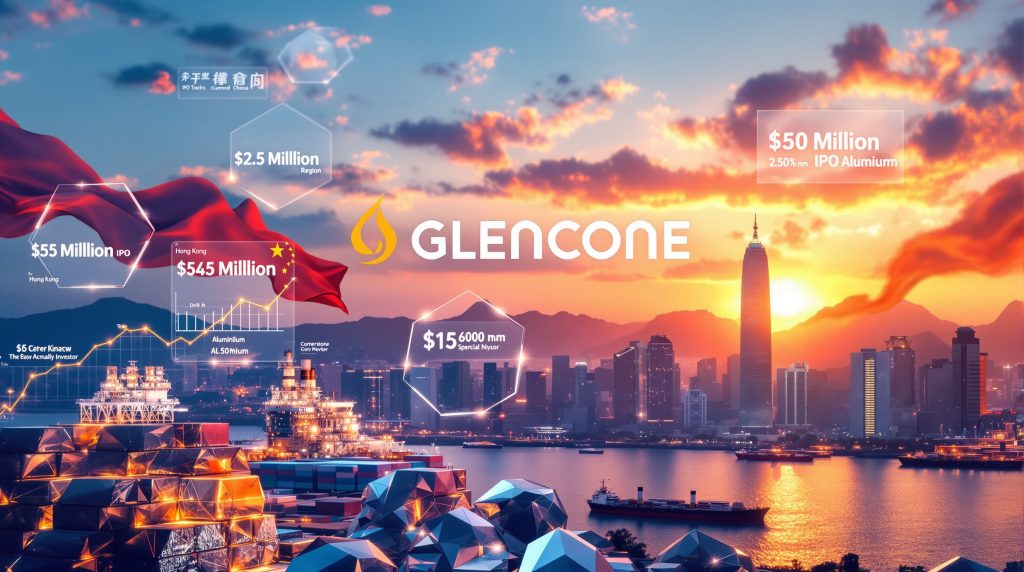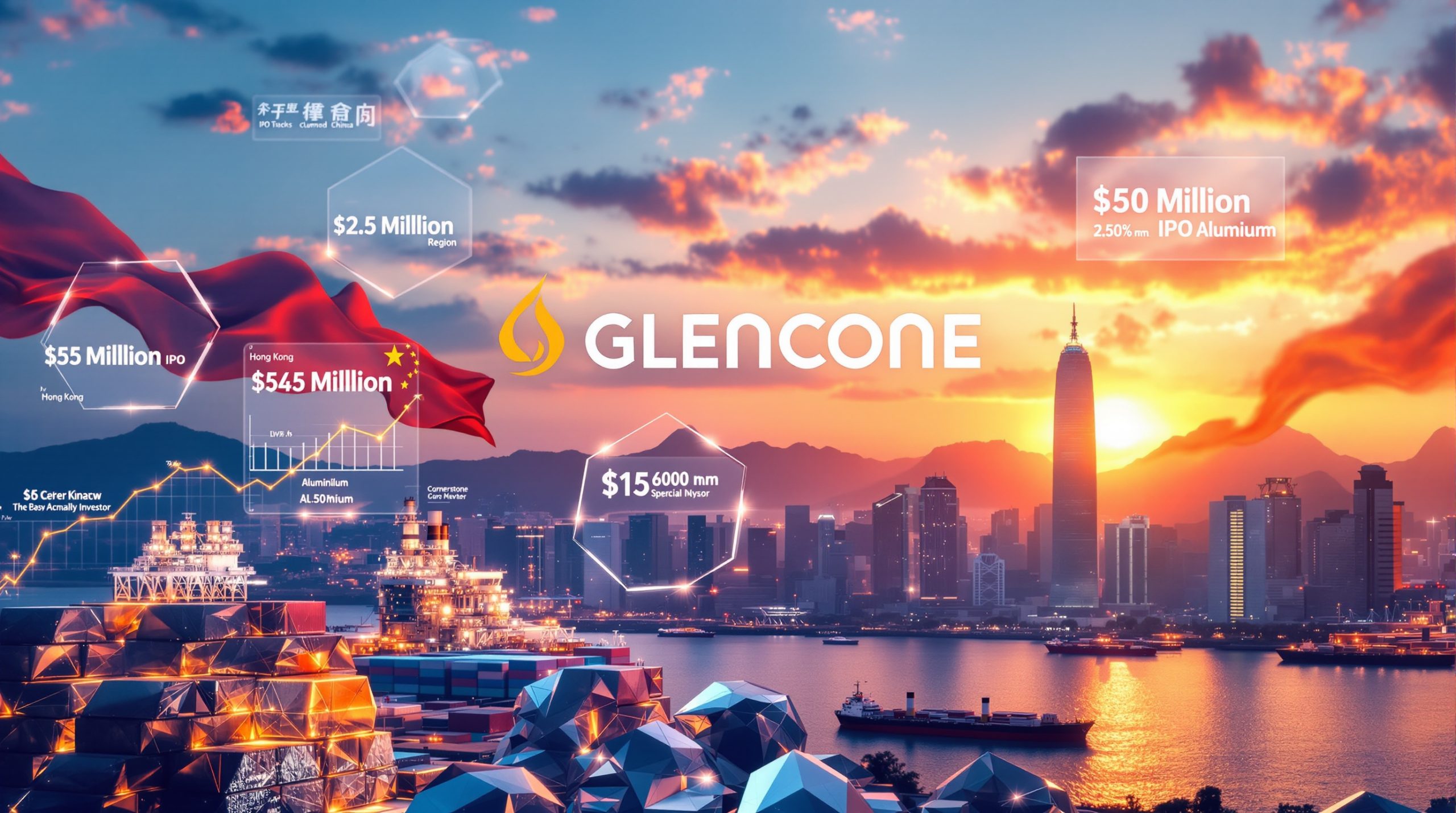What Is Glencore's Strategic Investment in Chuangxin Industries?
The global commodity trading landscape witnessed a significant development as Glencore Plc positioned itself as a cornerstone investor in Chuangxin Industries Holdings Ltd.'s Hong Kong initial public offering. This strategic Glencore investment in Chinese aluminum IPO represents more than a traditional financial investment, signaling the Swiss commodity giant's commitment to strengthening its position within China's aluminum supply chain.
Understanding the $700 Million Hong Kong IPO
Chuangxin Industries, based in Inner Mongolia, has structured its public offering to raise approximately $700 million through the Hong Kong Stock Exchange. The company initiated order-taking processes in mid-November 2025, positioning itself to capitalise on favourable aluminum market conditions and strong investor appetite for Chinese industrial assets.
The IPO represents a substantial capital raise within the context of Hong Kong's robust 2025 listing environment. Furthermore, Bloomberg Intelligence estimates suggest that Hong Kong listings could close 2025 at a four-year high, with total proceeds potentially exceeding $40 billion. This market momentum provides an advantageous backdrop for Chuangxin's public debut and highlights current capital raising methods available in regional markets.
Glencore's Role as Cornerstone Investor
Cornerstone investor status provides Glencore with guaranteed share allocation in exchange for specific holding period commitments. This arrangement differs fundamentally from traditional commodity trading relationships, representing a strategic equity participation model that aligns Glencore's interests with Chuangxin's operational performance and growth trajectory.
The cornerstone investor structure typically involves the following key elements:
• Guaranteed allocation: Pre-determined share quantities regardless of market demand
• Lock-up commitments: Holding periods that prevent immediate post-listing sales
• Price stability: Reduced volatility during initial trading periods
• Strategic signalling: Market confidence demonstration through institutional participation
Cornerstone investors collectively may purchase approximately 50% of the entire IPO deal, with Glencore joining Hillhouse Investment Management and China Hongqiao Group as major participants. This substantial cornerstone allocation provides unusual stability compared to typical Hong Kong IPO market conditions, particularly given recent volatility in new listing performance.
Why Are Major Players Backing This Chinese Aluminum Venture?
The convergence of favourable market dynamics has created compelling investment rationale for sophisticated institutional investors. Chinese aluminum markets are experiencing a unique combination of supply constraints and demand growth that supports elevated profitability across the sector, making it part of broader mining evolution trends currently reshaping global commodity markets.
Market Dynamics Driving Investment Interest
Aluminum prices reached three-year highs during late 2025, reflecting strong fundamental support from multiple market factors. The London Metal Exchange has witnessed aluminum emerge as one of the strongest performing base metals, driven by structural supply-demand imbalances.
Chinese aluminum smelters, which produce approximately 50% of global primary aluminum, are experiencing elevated profitability supported by two critical factors. However, understanding these market dynamics requires sophisticated investment strategies 2025 to navigate effectively.
| Market Driver | Impact Mechanism | Investment Implication |
|---|---|---|
| Government capacity ceiling | Supply constraint enforcement | Price support and margin protection |
| Renewable energy demand | Structural consumption growth | Long-term demand visibility |
| International trade dynamics | Export opportunity expansion | Revenue diversification potential |
The government-imposed capacity ceiling on Chinese aluminum production has effectively capped domestic supply growth, creating a supply-constrained environment that supports pricing power for existing producers. This regulatory framework provides revenue predictability that appeals to equity investors seeking stable cash flow generation.
Strategic Investor Lineup Analysis
The cornerstone investor composition reflects diverse strategic motivations and complementary capabilities:
Glencore Plc brings extensive commodity trading expertise and global market access, potentially facilitating international sales and supply chain optimisation for Chuangxin's production output.
Hillhouse Investment Management contributes sophisticated asset management capabilities and capital markets expertise, supporting strategic decision-making and potential future capital raising activities.
China Hongqiao Group, as the country's largest private aluminum producer, offers deep industry knowledge and potential operational synergies within the Chinese aluminum ecosystem. In addition, this collaboration demonstrates emerging industry consolidation trends across the sector.
This investor combination suggests that the investment thesis encompasses both commodity market fundamentals and strategic operational value creation opportunities.
How Does Chuangxin Industries Fit Into Global Aluminum Markets?
Chuangxin Industries operates within China's dominant aluminum production ecosystem, focusing on primary aluminum and alumina production from its Inner Mongolia manufacturing base. The company's geographic positioning provides access to abundant energy resources and proximity to key domestic consumption centres.
Company Profile and Operations
The company's business model centres on integrated aluminum production, encompassing both primary aluminum smelting and alumina refining capabilities. This vertical integration provides operational flexibility and cost optimisation opportunities within the aluminum value chain.
A notable aspect of Chuangxin's customer relationships involves Shanghai-listed Innovation New Material Technology Co., which represents the company's largest customer. Significantly, Chuangxin's chairman, Cui Lixin, also heads this customer company, creating potential vertical integration or strategic alignment considerations.
Inner Mongolia's strategic advantages for aluminum production include:
• Energy cost competitiveness: Access to coal-fired power generation
• Transportation infrastructure: Railway connections to major consumption centres
• Regulatory environment: Provincial support for industrial development
• Raw material access: Proximity to alumina refining facilities
China's Aluminum Industry Dominance
Chinese aluminum production represents approximately half of global primary aluminum output, establishing China as the decisive factor in international aluminum market dynamics. This production concentration creates both opportunities and dependencies for international commodity traders and consumers.
The scale of Chinese aluminum production influences global pricing mechanisms, trade flows, and supply chain strategies across multiple industries. For instance, commodity traders like Glencore recognise that direct equity participation in Chinese production assets provides supply chain security and market intelligence advantages that traditional trading relationships cannot offer.
China's aluminum industry characteristics include:
| Metric | Global Significance | Market Implications |
|---|---|---|
| Production volume | 50% of world output | Price discovery influence |
| Export capacity | Swing supplier role | International market impact |
| Consumption growth | Domestic demand expansion | Supply availability for exports |
| Technology advancement | Smelting efficiency improvements | Cost competitiveness enhancement |
What Are the Investment Implications for Aluminum Markets?
The $700 million IPO represents substantial capital deployment within the global aluminum sector, with implications extending beyond individual company performance to broader market dynamics and investor sentiment. This Glencore investment in Chinese aluminum IPO demonstrates how strategic capital allocation requires careful asset allocation components consideration.
Financial Structure and Valuation Metrics
Cornerstone investor participation of approximately 50% of the total deal provides unusual price stability and institutional validation compared to typical Hong Kong IPO structures. This substantial pre-commitment reduces execution risk and demonstrates sophisticated investor confidence in the investment thesis.
The timing of the IPO coincides with Hong Kong market strength, with 2025 listings tracking toward four-year highs and potential total proceeds exceeding $40 billion. However, recent individual listing performance has shown volatility, with some new issues experiencing poor initial trading performance despite overall market strength.
Market Timing and Strategic Positioning
The IPO's November 2025 timing capitalises on favourable aluminum market conditions and strong institutional investor appetite for commodity-linked assets. However, market participants have demonstrated increasing selectivity, with some recent Hong Kong listings experiencing disappointing debuts despite banner year conditions.
Key timing considerations include:
• Aluminum price momentum: Three-year highs supporting sector valuations
• Hong Kong market conditions: Strong overall IPO proceeds but selective performance
• Institutional appetite: Major cornerstone investor participation demonstrating confidence
• Regulatory environment: Stable Hong Kong listing requirements and compliance framework
The combination of favourable commodity fundamentals and substantial cornerstone investor commitment suggests reduced execution risk compared to typical market conditions.
How Will This Impact Global Commodity Trading Dynamics?
Glencore's equity participation represents a strategic evolution from traditional commodity trading relationships toward direct supply chain integration. This approach provides enhanced visibility into production costs, operational capabilities, and market intelligence that supports more sophisticated trading strategies.
Glencore's Portfolio Expansion Strategy
The investment aligns with broader trends among international commodity traders toward equity participation in key supply chain assets. Rather than relying solely on arms-length trading relationships, this approach provides operational insight and supply security that enhances competitive positioning.
For Glencore, the investment potentially offers several strategic advantages:
• Supply chain visibility: Direct access to production planning and cost information
• Market intelligence: Enhanced understanding of Chinese aluminum industry dynamics
• Trading optimisation: Improved ability to structure derivative and physical transactions
• Risk management: Diversification beyond pure trading income streams
Competitive Landscape Implications
The transaction may signal broader industry consolidation trends as commodity traders seek to secure access to key production assets. With Chinese producers controlling 50% of global primary aluminum production, equity participation provides strategic positioning that pure trading relationships cannot replicate.
This development could influence aluminum pricing mechanisms by reducing the traditional separation between producers and traders. Consequently, enhanced information flow and aligned incentives may contribute to more efficient price discovery and risk management across the aluminum value chain.
According to Glencore's reported investment in the Chinese aluminum smelter's IPO, commodity traders increasingly recognise that equity participation in key supply chain assets provides competitive advantages beyond traditional trading margins, particularly in markets dominated by specific geographic regions or regulatory frameworks.
What Challenges and Opportunities Lie Ahead?
The investment faces both sector-specific risks and broader market challenges that could influence returns and strategic value realisation. Understanding these factors provides insight into the investment's risk-reward profile and potential outcome scenarios.
Regulatory and Market Risk Assessment
Hong Kong listing requirements establish compliance frameworks and ongoing disclosure obligations that will govern Chuangxin's public company operations. The regulatory environment generally supports international investor participation while maintaining transparency standards that facilitate institutional investment.
Chinese aluminum industry regulations, particularly environmental standards and production capacity management, create both constraints and opportunities. For instance, the government-imposed capacity ceiling that currently supports profitability could potentially be modified based on policy priorities or market conditions.
Key regulatory considerations include:
• Environmental compliance: Emissions standards and energy efficiency requirements
• Production permits: Capacity ceiling enforcement and expansion approvals
• International trade: Export policies and tariff implications
• Corporate governance: Hong Kong listing standards and disclosure requirements
Growth Potential and Future Outlook
Renewable energy sector demand provides structural growth opportunities for aluminum consumption, supporting long-term investment fundamentals. Solar panel frameworks, wind turbine components, and electric vehicle applications represent expanding end-use markets with favourable growth trajectories.
Aluminum market fundamentals through 2025-2026 appear supportive based on supply-demand balance projections and infrastructure investment trends. However, commodity markets remain cyclical, and aluminum prices will likely experience volatility based on global economic conditions and industrial production levels.
Potential growth catalysts include:
| Opportunity | Timeline | Market Impact |
|---|---|---|
| Renewable energy expansion | 2025-2027 | Structural demand growth |
| Infrastructure investment | Ongoing | Consumption support |
| Export market development | Medium-term | Revenue diversification |
| Production efficiency improvements | Continuous | Cost competitiveness |
Key Takeaways for Investors and Industry Watchers
The Glencore investment in Chinese aluminum IPO represents a strategic evolution in commodity trading business models, emphasising equity participation over traditional trading relationships. This approach reflects sophisticated institutional recognition of China's dominant position in global aluminum markets.
Investment Decision Factors
The investment thesis combines commodity market fundamentals with strategic positioning considerations. Aluminum's three-year price highs and government-imposed supply constraints create favourable near-term conditions, while renewable energy demand growth provides longer-term structural support.
Risk factors include commodity price volatility, regulatory changes in Chinese aluminum industry policy, and broader Hong Kong market conditions affecting IPO performance. However, substantial cornerstone investor participation suggests institutional confidence in risk-adjusted return potential.
Broader Industry Implications
The transaction may signal broader trends toward supply chain integration among international commodity traders. As global production concentrates in specific regions, equity participation provides competitive advantages that traditional trading relationships cannot replicate.
For the aluminum industry, the investment represents continued institutional confidence in Chinese production capabilities and market fundamentals. Furthermore, as noted in Business Times coverage, the combination of supply constraints and demand growth creates investment conditions that appeal to sophisticated global institutions.
This strategic Glencore investment in Chinese aluminum IPO demonstrates how major commodity traders are adapting their business models to secure supply chain advantages in an increasingly complex global marketplace.
This analysis is based on publicly available information as of November 2025. Commodity investments involve significant risks including price volatility, regulatory changes, and market conditions. Investors should conduct independent research and consider professional advice before making investment decisions.
Looking to Capitalise on Commodity Market Opportunities?
Discovery Alert's proprietary Discovery IQ model delivers real-time alerts on significant ASX mineral discoveries, instantly empowering subscribers to identify actionable opportunities ahead of the broader market. Explore how major mineral discoveries can lead to substantial market returns by visiting Discovery Alert's dedicated discoveries page, showcasing historic examples of exceptional outcomes, and begin your 30-day free trial today to position yourself ahead of the market.




